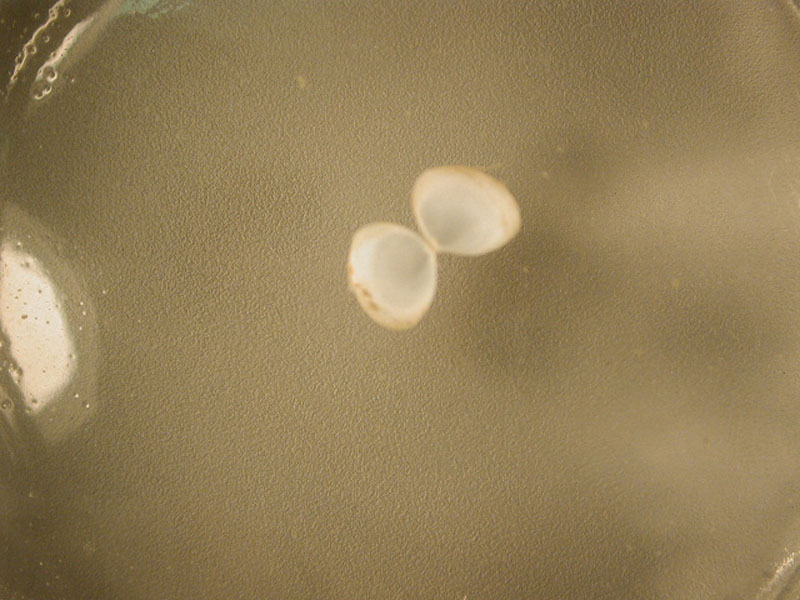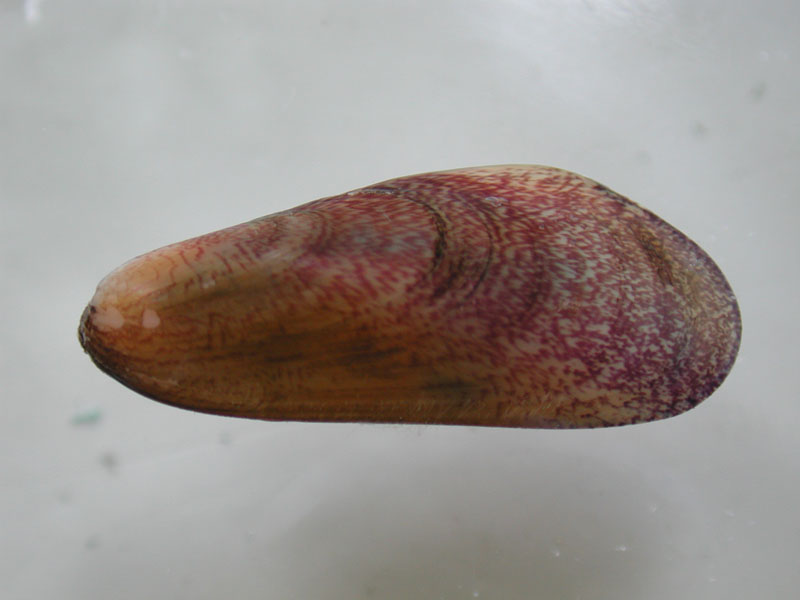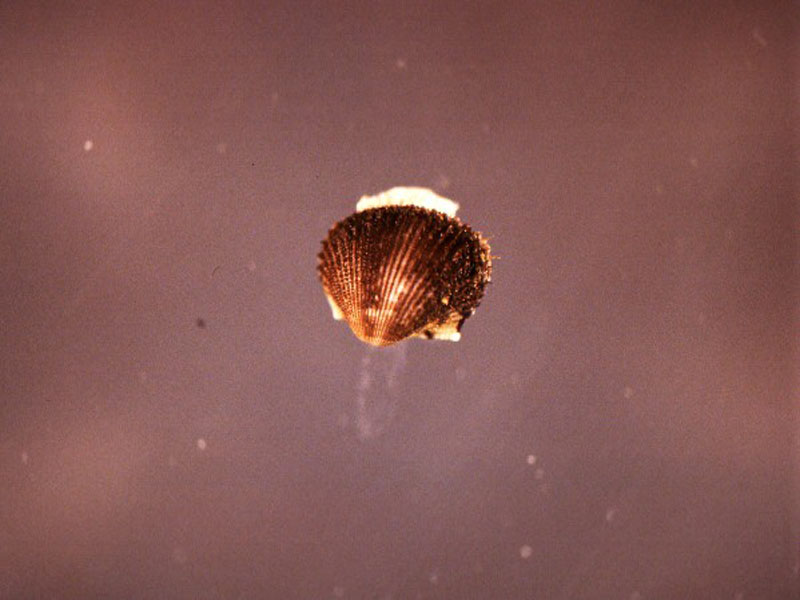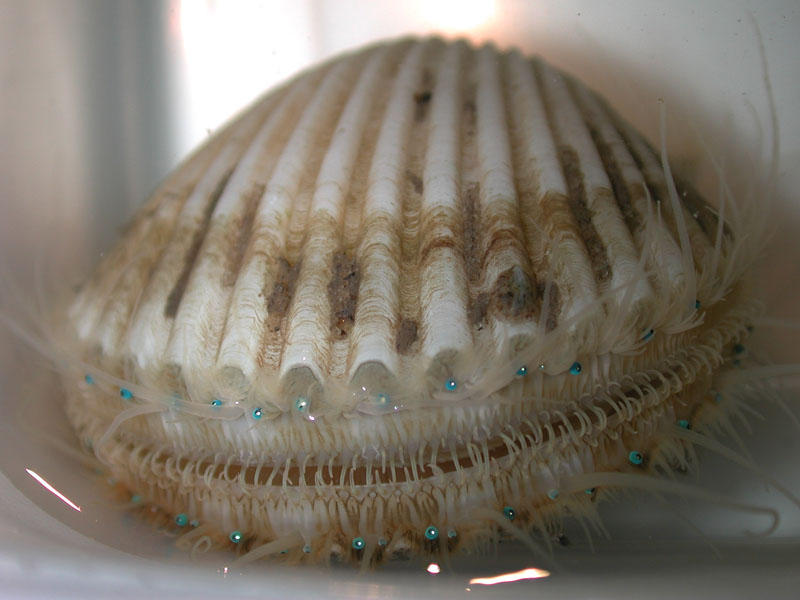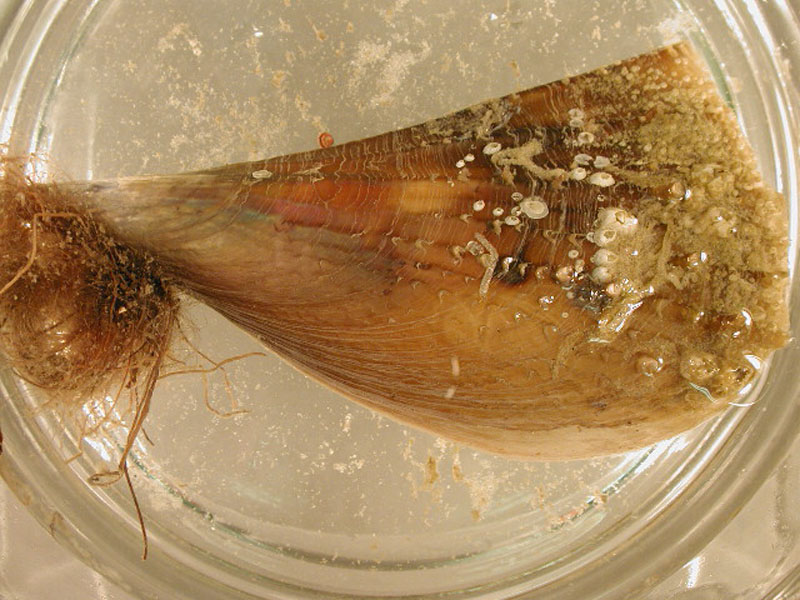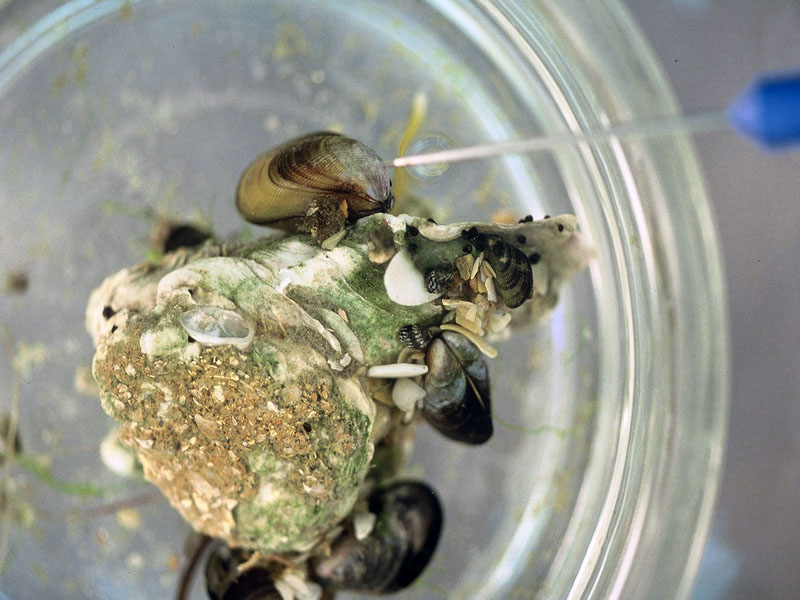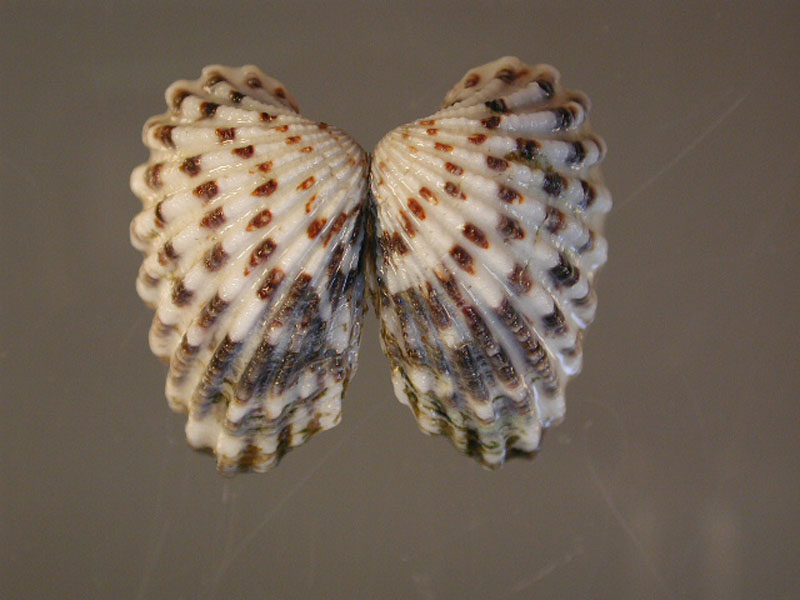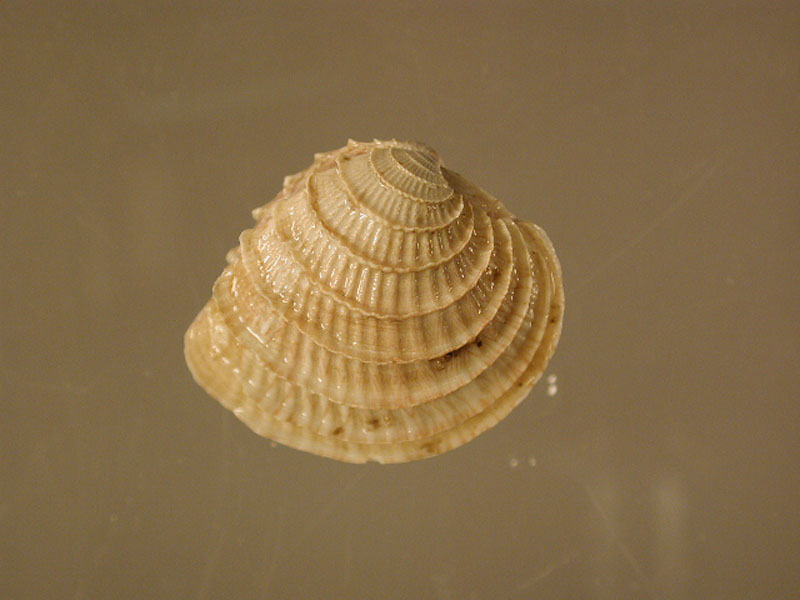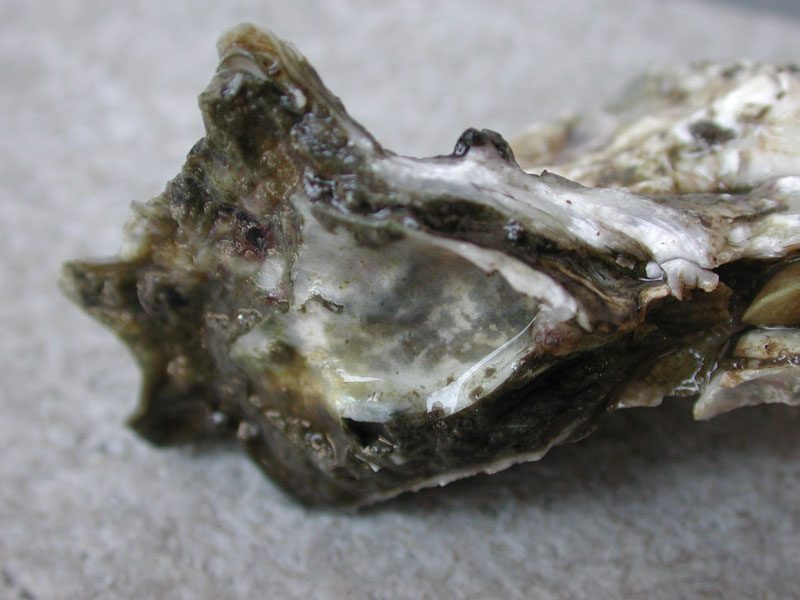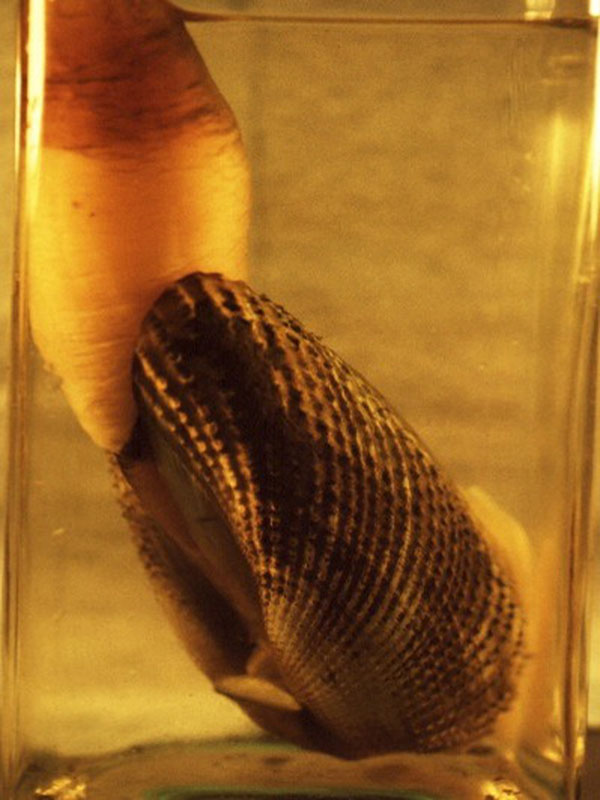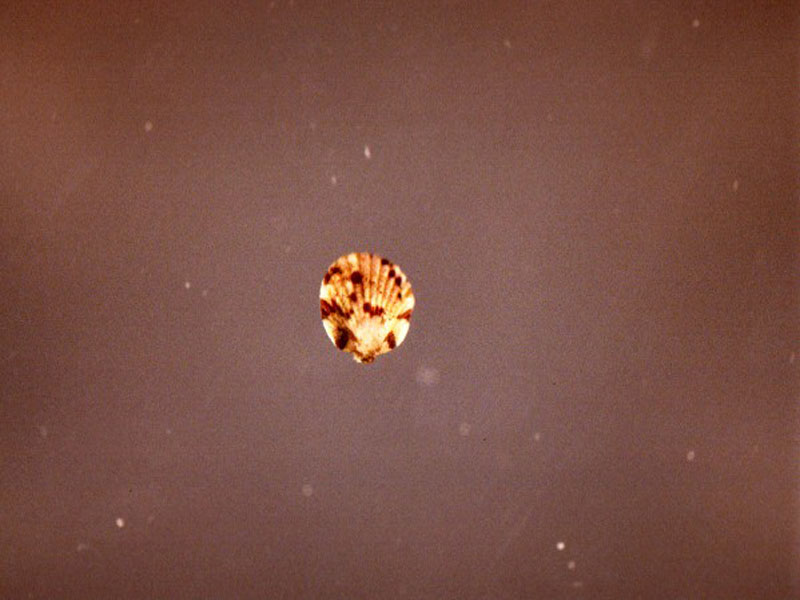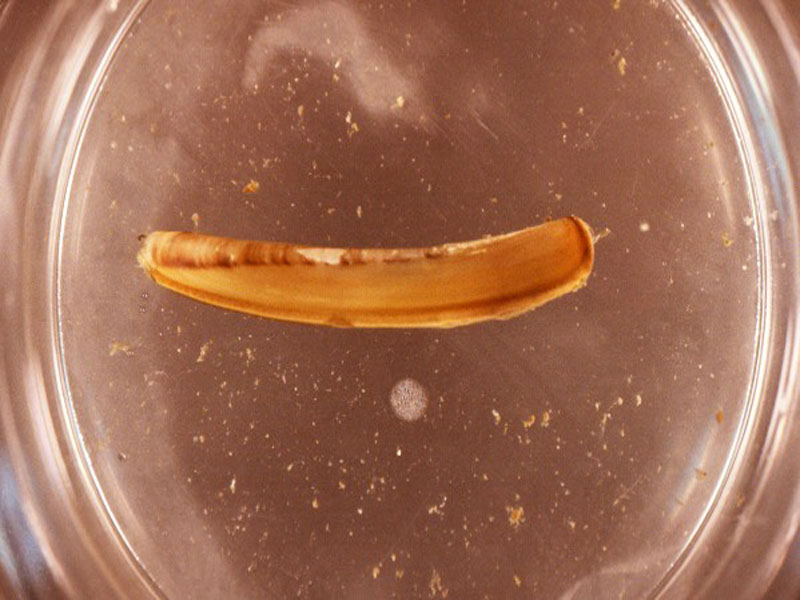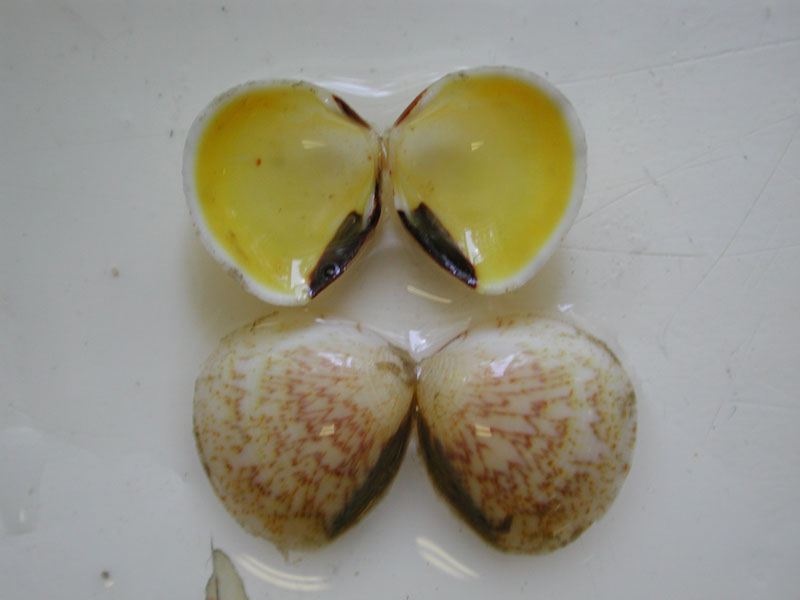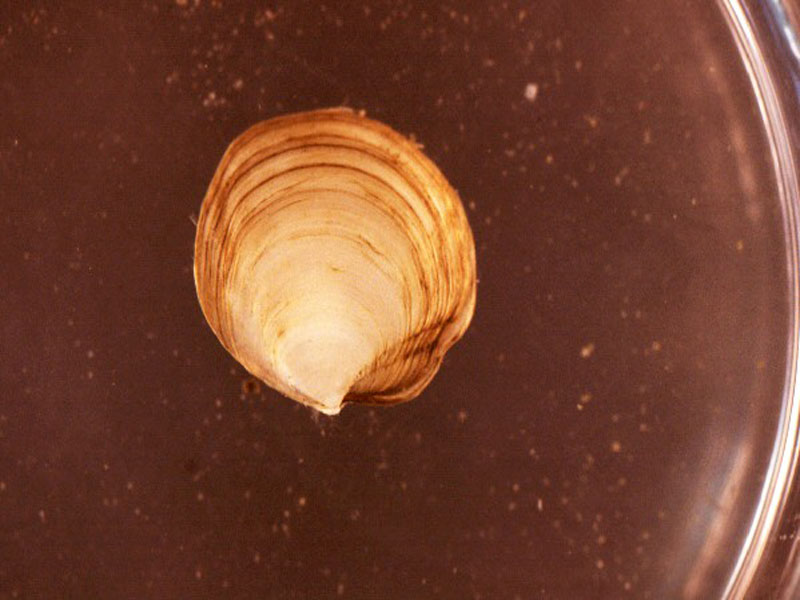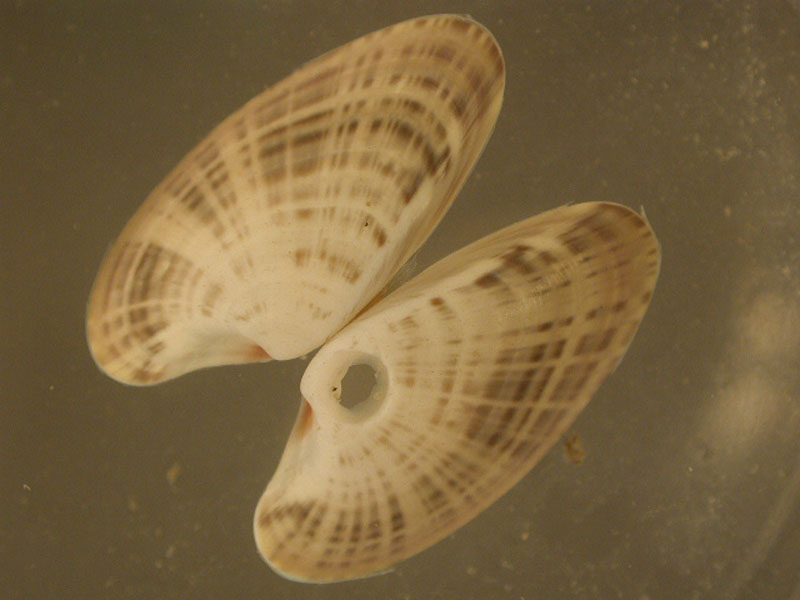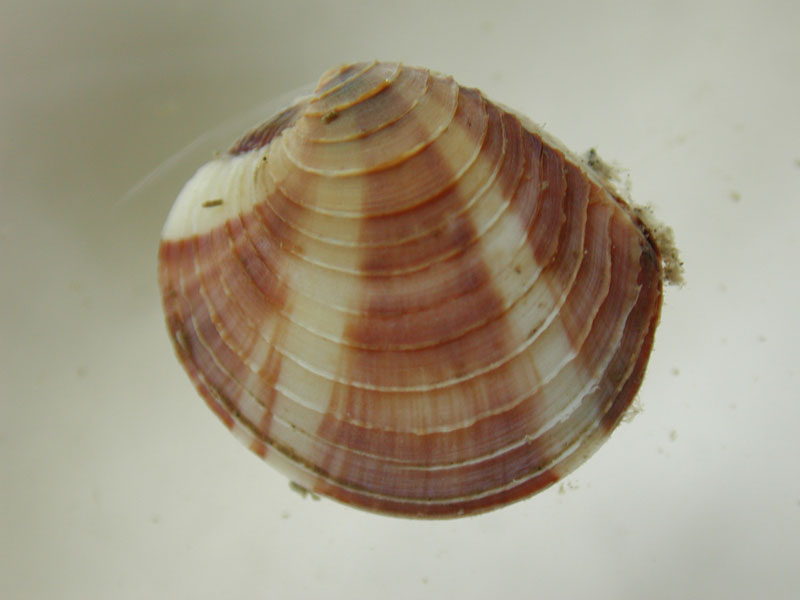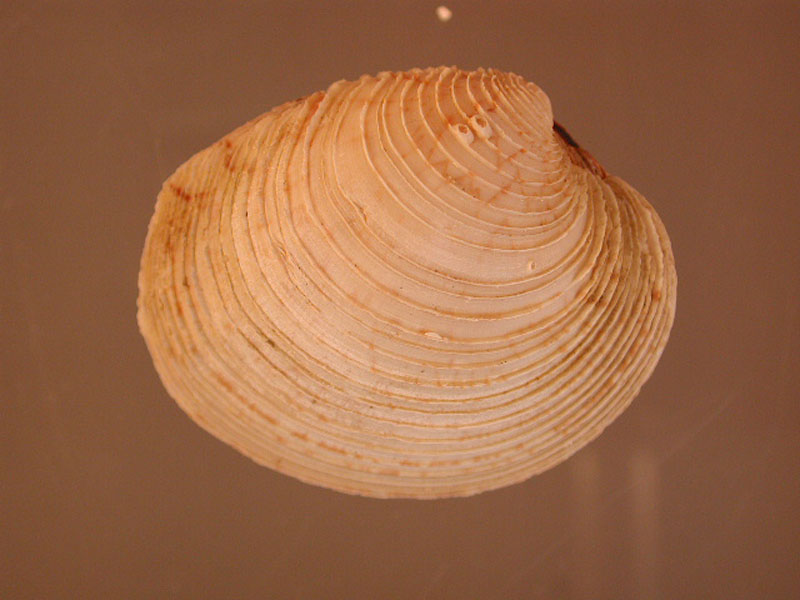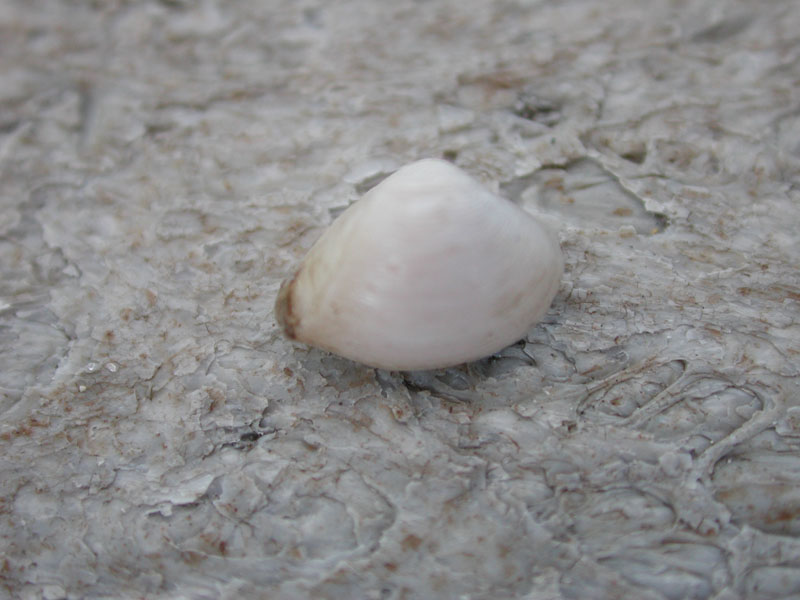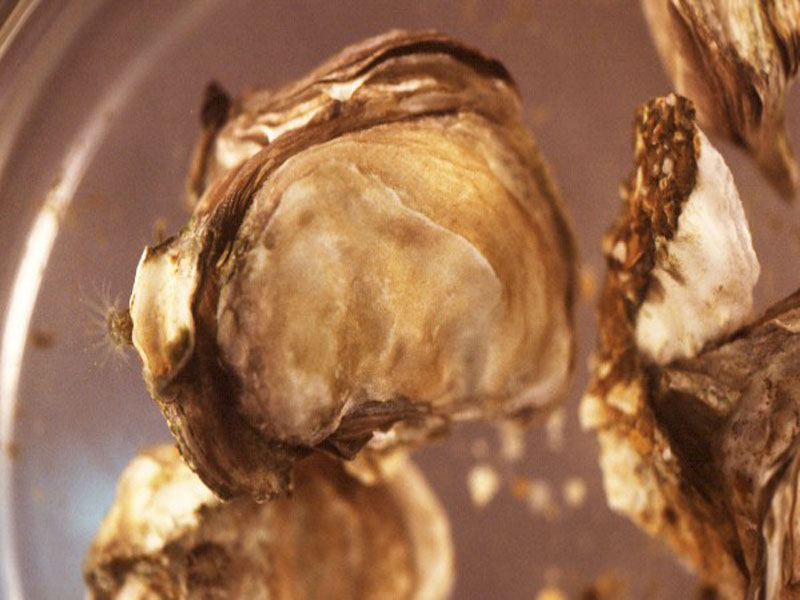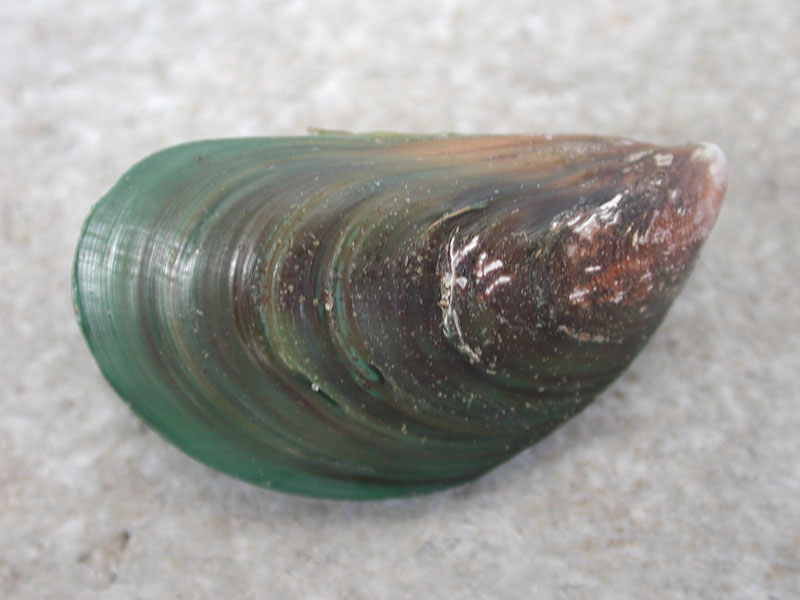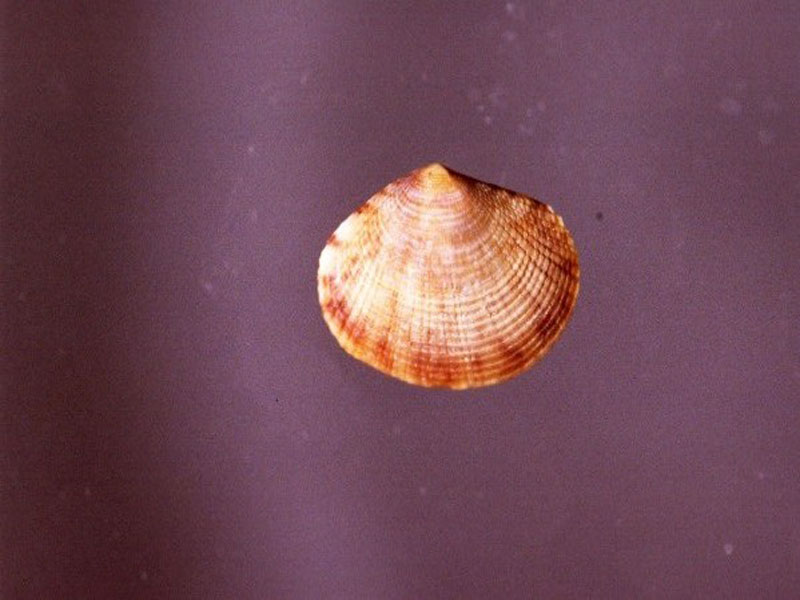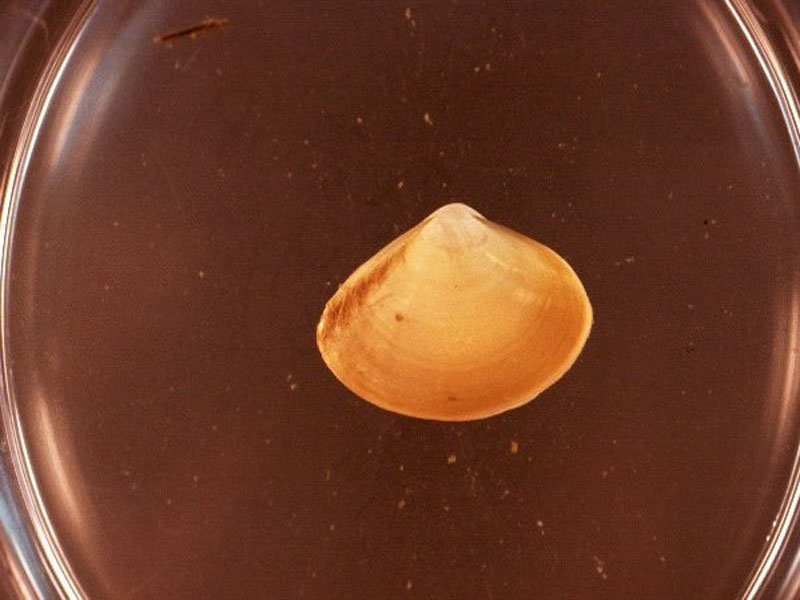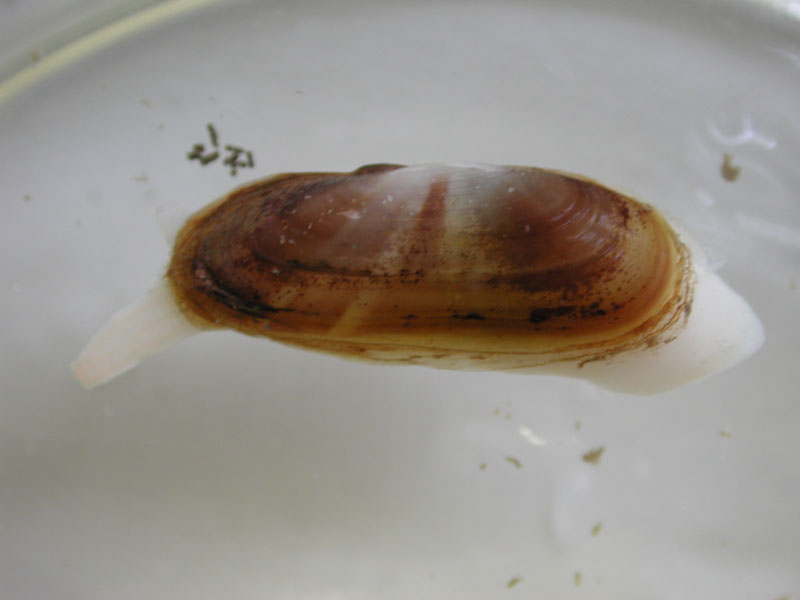Clam-like
Atlantic Abra, Nut Clam
Description
Atlantic abra or nut clams can be very abundant in shallow sand flats. The plump shells are translucent white, smooth and glossy, and may be slightly iridescent. There is a very thin clear to yellowish covering (periostracum) on the shells. The Atlantic abra grows to only ¼ inches in length.
What Are The Effects On Clams?
Atlantic abra clams are found in clam bags and are often abundant in raceways. They are deposit-feeders, consuming sediment and extracting the organic material. They would, therefore, remove and recycle clam fecal material from the culture bags or raceways.
- FRIEND
What Can A Clam Farmer Do?
As non-competing deposit feeders, Atlantic abra clams can be left in culture bags and raceways.
Atlantic Paper Mussel
Description
Atlantic paper mussels are found in soft muddy environments or attached to seagrasses in shallow water. The fragile shells are elongate, smooth, and glistening. The outsides of the shells are two-toned with bluish green and yellowish brown, while the insides of the shells are iridescent white. Atlantic paper mussels grow to 1 inch in length.
What Are The Effects On Clams?
Atlantic paper mussels are filter feeders and, therefore, can compete for the same type of food (micro algae) as clams. The “beard” or byssal threads may ball up and trap small clam seed.
- FOE
- Competitor
- Fouler
What Can A Clam Farmer Do?
Atlantic paper mussels are infrequently found in clam bags and rarely pose a problem. However, caution should be taken in land-based nurseries. Manual removal of mussels from wellers and raceways is recommended to eliminate entrapment of small seed (1-3 mm) in the mussel’s byssal threads.
Transverse Ark
Description
Transverse arks are fairly common and burrow shallowly in silty sand, with one end exposed. As juveniles, they may also live attached to rocks or other materials by a “beard” (byssal threads). The shells are somewhat rectangular, with a grayish-brown, felt-like shell covering (periostracum) that may be partially worn away. Transverse arks grow to 1.5 inches in size.
What Are The Effects On Clams?
Transverse arks are filter feeders and, therefore, can compete for the same type of food (micro algae) as clams.
- FOE
- Competitor
What Can A Clam Farmer Do?
Transverse arks are infrequently found in clam bags and rarely pose a problem.
Common Jingle Shell
Description
The jingle shell is a widely distributed bivalve found from Canada to the West Indies. They are often found attached to logs, boats, and docks. The shell is extremely thin, colored a dull yellow or silver. The lower valve, or shell, has a hole near the apex for byssal threads to attach to substrate. They are suspension or filter feeders, catching plankton that drifts by. They get their name because the shells collected from dead specimens cause a jingling sound when shaken together. They are often found in tourist shops, strung together as wind chimes. Common jingles can reach up to 2 inches in length.
What Are The Effects On Clams?
Common jingles are filter feeders and, therefore, can compete for the same type of food (micro algae) as clams. They may attach to dead clam shells.
- FOE
- Competitor
- Fouler
What Can A Clam Farmer Do?
Common jingles are infrequently found in clam bags and rarely pose a problem.
Florida Bay Scallop
Description
Florida bay scallops live in seagrass beds in relatively shallow water, 4 to 10 feet deep. The shells have 19 to 21 square ribs. One shell is typically white and much fatter than the other shell, which is bluish gray to brown. The two “ears” at the hinge are about the same length. Florida bay scallops grow to 2 to 3 inches. This subspecies was once plentiful throughout Florida’s west coast. An extensive scallop fishery existed in Tampa Bay as recently as the 1960s, but scallops are rarely found there now. Currently, the most extensive bay scallop populations are located north and west of the Suwannee River where recreational harvests are allowed during the summer months.
What Are The Effects On Clams?
Florida bay scallops are filter feeders and, therefore, can compete for the same type of food (micro algae) as clams.
- FOE
- Competitor
What Can A Clam Farmer Do?
Florida bay scallops are infrequently found in clam bags and rarely pose a problem.
Stiff Pen Shell
Description
The stiff pen shell is a large bivalve ranging from North Carolina to the West Indies, from intertidal waters to 90 feet deep. It has a fan shape, with 15-20 radiating ribs along the valves, with the apex, or top, buried in the sand and the wide end exposed above the mud. It uses byssal threads to attach deep within the mud, often making it hard to pull out of the substrate. The exposed end is often covered in fouling organisms, such as barnacles and bryozoans. The shell is a dark olive brown color, with the internal tissue a bright golden orange, and iridescent mother of pearl (nacre) present on the inside of the valves.
What Are The Effects On Clams?
Stiff pen shells are found either in clam culture bags or attached to the outside of the bag by its “beard,” or byssal threads. The “beard” may ball up and trap small clam seed. Pen shells are filter feeders and, therefore, can compete for the same type of food (micro algae) as clams.
- FOE
- Competitor
- Fouler
What Can A Clam Farmer Do?
Pen shells can frequently be found on the outside of bags, but can easily be removed and rarely pose a problem.
Scorched Mussel
Description
The scorched mussel is small, up to 1.2 inches, and attaches to hard substrates such as rocks and oyster beds using byssal threads. It has a yellow to dark brown color, and thick-ribbed valves. The name “scorched” comes from the lack of a hairy outer surface common on other mussels called the periostracum. Scorched mussels are the most common of the mussels seen in intertidal zones in the southeastern U.S. These mussels are known for forming dense mats along hard substrates that can actually break waves.
What Are The Effects On Clams?
Scorched mussels are filter feeders and, therefore, can compete for the same type of food (micro algae) as clams. The “beard” or byssal threads may ball up and trap small clam seed.
- FOE
- Competitor
What Can A Clam Farmer Do?
Scorched mussels are infrequently found in clam bags and rarely pose a problem.
Broad-ribbed Carditid
Description
The broad-ribbed carditid is named so for its relatively wide 20 ribs along each thick valve, or shell. The ribs are rounded and beaded, often with brown flecks on them. The shell is oval, and over 1 inch long, with brown concentric rings on a white-yellow background. The periostracum, or shell covering, is grey, while the interior is white. The broad-ribbed carditid uses byssal threads to attach to substrate, often in mud flats. It is a common bivalve in the shallow waters of the Gulf of Mexico.
What Are The Effects On Clams?
Broad-ribbed carditids are filter feeders and, therefore, can compete for the same type of food (micro algae) as clams.
- FOE
- Competitor
What Can A Clam Farmer Do?
Broad-ribbed carditids are infrequently found in clam bags and rarely pose a problem.
Cross-Barred Venus
Description
Cross-barred venus clams are common shallow water bivalves found in clean or slightly silty sand. They have short siphons and live at the surface, with one end protruding from the sediment. Shells are thick with a grid-work of raised concentric ridges and many course radial ribs. Outside shell color is white to gray or yellow and may be decorated with zigzag or triangular patches of purplish brown. The inside is glossy-white with purplish blue. Cross-barred venus clams are less than 1½ inches in length.
What Are The Effects On Clams?
Cross-barred venus clams are filter feeders and, therefore, can compete for the same type of food (micro algae) as clams.
- FOE
- Competitor
What Can A Clam Farmer Do?
Cross-barred venus clams occur infrequently in clam bags and rarely pose a problem. Note that they may be confused with juvenile hard clams, Mercenara mercenaria.
Eastern Oyster
Description
This economically important bivalve is very common in intertidal zones in the southeastern and Gulf of Mexico states, and forms large reefs on mud flats and rocks. Oysters can tolerate a wide range of salinities, from estuaries to salt marshes. They can grow to 6 inches in length, with elongate, irregular, asymmetric valves that have sharp edges. Oysters spawn throughout the summer, giving rise to free-swimming larvae that look for suitable hard substrate to cement onto, often times onto an existing oyster reef. In Florida, oysters can reach an edible size of 3 inches in a year or less. Oyster reefs are homes to many creatures, including fish, gastropods (including the predatory oyster drill), other bivalves, polychaete worms, shrimps, and crabs.
What Are The Effects On Clams?
Oysters can have a two-fold effect on clams. As a filter or suspension feeder, oysters can compete for the same type of food (micro alga) as clams. They can also attach to clam bags and cover netting and to the clam shells themselves. This can result in mechanical interference and prevent the clam from opening, feeding or burying. Fouling on the clam shell can make them less desirable for marketing. The eastern oyster grows much faster than clams and under the right conditions (lower salinities) can rapidly “take over” a clam bag resulting in clam mortalities due to suffocation. Clam bags which contain a large set of oysters can be difficult to remove from the lease. Often they are not recovered, resulting in the creation of a small oyster “reef.”
- FOE
- Competitor
- Fouler
What Can A Clam Farmer Do?
The best approach to minimize oyster set is to not plant clam bags on hard lease bottoms during peak periods of oyster spawning. Unfortunately, oyster set can occur periodically from April through October in Florida. To minimize fouling on the clams and bags, a clam farmer could add cover netting during periods of peak sets and remove afterwards, basically harvesting the oysters. Note that plastic or rigid cover netting can also “attract” oyster spat and may become the problem. Dipped bags which stiffen the mesh may also provide suitable substrate for oysters. Clam bags fouled with oysters should be removed from the lease as soon as possible. Gloves are necessary when handling bags covered with oysters as they are very sharp and can cause serious injuries.
Angel Wing Clam, Snout Clam
Description
Angel wing clams bore into silty sand or clay in the high subtidal area. They live in burrows as deep as 2 feet and can move up and down. The elongate shells, with about 30 beaded ribs, are pure white with a thin gray covering (periostracum). The shells gape widely and cannot completely enclose the soft body. Angel wings can grow up to 5 to 7 inches in shell length, although the body is much longer.
What Are The Effects On Clams?
Angel wing clams are filter feeders and, therefore, can compete for the same type of food (micro algae) as clams.
- FOE
- Competitor
What Can A Clam Farmer Do?
Angel wing clams are infrequently found in clam bags and rarely pose a problem.
Atlantic Giant Cockle
Description
Atlantic giant cockles live in sand in shallow to intertidal waters. Shells of the Atlantic giant cockle are inflated and have strong, smooth, ribs. They have a narrow foot used to burrow quickly or “leap” away from predators. There are two short, separate, siphons with fine tentacles. Cockles are heart-shaped when viewed from either end. Atlantic giant cockles grow to 4 inches in size.
What Are The Effects On Clams?
Atlantic giant cockles are filter feeders and, therefore, can compete for the same type of food (micro algae) as clams.
- FOE
- Competitor
What Can A Clam Farmer Do?
Atlantic giant cockles are infrequently found in clam bags and rarely pose a problem.
Disk Dosinia, Disk Clam
Description
Disk dosinia clams live in shallow waters, preferring sandy tidal flats with no surf. They burrow rapidly, with a rocking motion, to about 4 inches deep. The circular shells are strongly compressed and have uniformly spaced, fine, concentric lines. Shells are glossy white, with a thin yellowish covering (periostracum) but may be stained black from the sediments. Adults grow to 3 inches in length.
What Are The Effects On Clams?
Disk dosinia clams are filter feeders and, therefore, can compete for the same type of food (micro algae) as clams.
- FOE
- Competitor
What Can A Clam Farmer Do?
Disk dosinia clams occur infrequently in clam bags and rarely pose a problem.
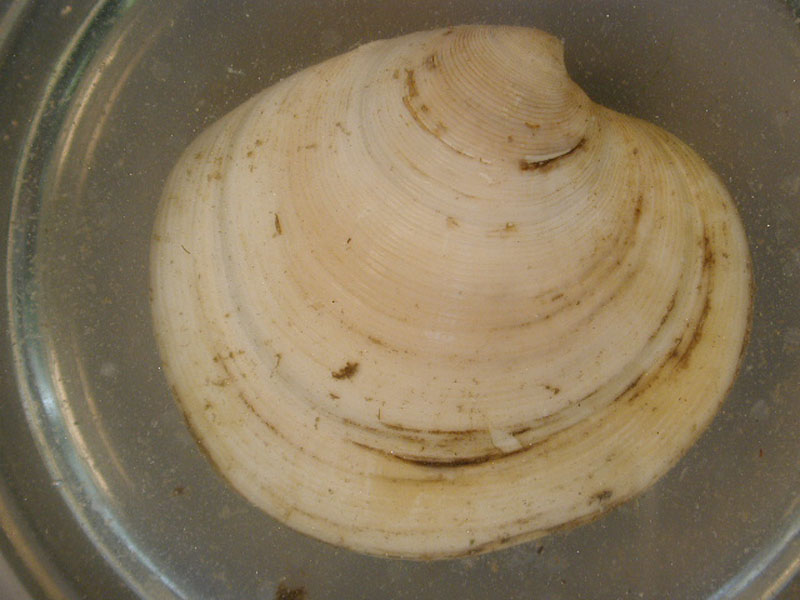
Taxonomy
- Kingdom:Animalia
- Phylum: MOLLUSCA
- SubPhylum:
- Class: Bivalvia
- Order: Veneroida
- Family: Veneridae
- Genus: Dosinia
- Species: discus
Minor Jackknife Clam, Razor Clam
Description
Minor jackknife clams are moderately common in shallow waters, preferring fine, muddy, sand and strong currents. They can burrow very rapidly. The slightly curved shells are fragile and more than 6 times as long as they are high. The outside of the shell is covered with a thin, glossy covering (periostracum) that is green, brown, or purplish in color. The inside of the shell has purple stains. Minor jackknife clams rarely exceed 3 inches in length.
What Are The Effects On Clams?
Minor jackknife clams are sometimes found attached to the outside of clam culture bags. They are filter feeders and, therefore, can compete for the same type of food (micro algae) as clams.
- FOE
- Competitor
What Can A Clam Farmer Do?
Minor jackknife clams are infrequently found and rarely pose a problem.
Morton's Egg Cockle, Yellow Egg Cockle
Description
Morton's egg cockle is a small species ranging from Massachusetts to the Gulf of Mexico. It has a thin but strong shell that appears inflated and glossy, with a cream color and purplish zigzags. The interior may be a bright yellow, and the margins of the two valves are smooth. Cockles are heart-shaped when viewed from either end. It is often found on sandy substrate from intertidal zones to about 20 feet of depth. It has short siphons for breathing and feeding and is found buried rather shallow in the sand.
What Are The Effects On Clams?
Morton’s egg cockles, or yellow egg cockles, are filter feeders and, therefore, can compete for the same type of food (micro algae) as clams.
- FOE
- Competitor
What Can A Clam Farmer Do?
Yellow egg cockles are infrequently found in clam bags and rarely pose a problem.
Florida Lucine
Description
The Florida lucine is commonly found in the Gulf of Mexico, and buries in intertidal sands from shore to about 40 foot depth. It uses a worm-like siphon to form a mucus-lined tube in the sand for incurrent water. The siphon is retracted into the shell similar to the finger of a glove turning inside-out, and is used to keep the incurrent tube free of debris. It has a rounded shape, compressed shell, and is fairly smooth with some irregular growth lines. The periostracum, or shell covering, is a light tan, and is flaky to the touch. Florida lucines grow to about 1 inch in length.
What Are The Effects On Clams?
Florida lucines are filter feeders and, therefore, can compete for the same type of food (micro algae) as clams.
- FOE
- Competitor
What Can A Clam Farmer Do?
Florida lucines are infrequently found in clam bags and rarely pose a problem.
Constricted Macoma
Description
Constricted macoma clams are common just offshore. They are active burrowers in soft sediments. Shells are dingy-white and chalky with growth rings stained by a gray or yellow covering (periostracum). The elongate end of the shell (posterior) is twisted to one side and has a blunt point. Constricted macoma clams grow to 2.5 inches in length.
What Are The Effects On Clams?
Constricted macoma clams are deposit-feeders, consuming sediment and extracting the organic material. They would, therefore, remove and recycle clam fecal material from culture bags. In addition, their active burrowing may help aerate the sediments.
- FRIEND
What Can A Clam Farmer Do?
As non-competing deposit feeders, constricted macoma clams can remain in the culture bags.
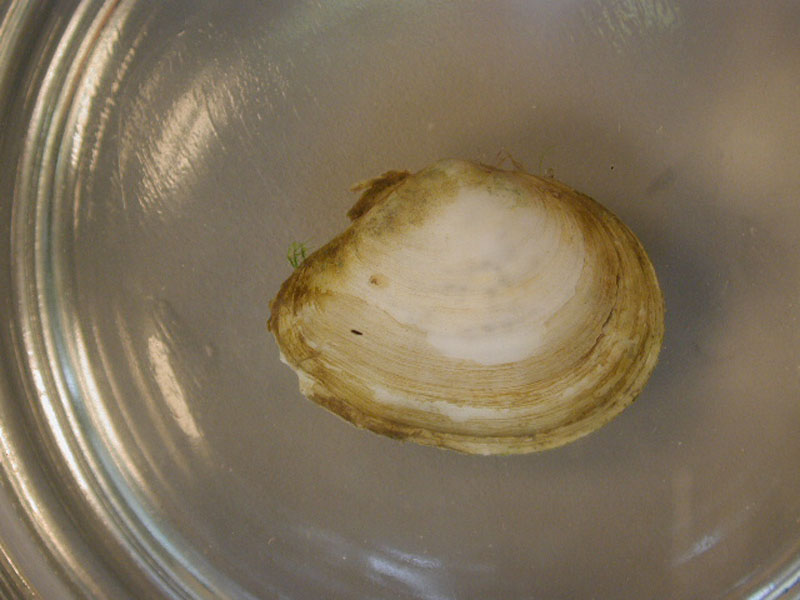
Taxonomy
- Kingdom:Animalia
- Phylum: MOLLUSCA
- SubPhylum:
- Class: Bivalvia
- Order: Veneroida
- Family: Tellinidae
- Genus: Macoma
- Species: constricta
Sunray Venus
Description
The sunray venus is so named due to the glossy brown or lavender color with a sunburst of dark bands radiating from the umbo (oldest part of the shell near the hinge) to the edges of the elongate valves (shells). They can grow to about 5 inches in length, and are found in low energy sandy intertidal zones, from North Carolina to the Gulf of Mexico. There are teeth concentrated near the umbo of the clam. The flesh is a pink color and sunray venus clams are often harvested recreationally for food. They bury themselves in the sand with a strong foot. Grooves in the sand indicate their presence just beneath the surface.
What Are The Effects On Clams?
Sunray venus clams are filter feeders and, therefore, can compete for the same type of food (micro algae) as clams.
- FOE
- Competitor
What Can A Clam Farmer Do?
Sunray venus clams are infrequently found in clam bags and rarely pose a problem. It should be noted that sunray venus clams are being considered as a potential aquaculture species.
Fragile Surf Clam
Description
Fragile surf clams live in intertidal and high subtidal sandy areas. They have smooth, off-white to yellowish shells with a silky shell covering (periostracum). The shells are an elongate oval and, when closed, there is a wide gape at one end for the foot to emerge from. The hinge is centrally located. Fragile surf clams can grow up to 2.5 inches.
What Are The Effects On Clams?
Fragile surf clams are filter feeders and, therefore, can compete for the same type of food (micro algae) as clams.
- FOE
- Competitor
What Can A Clam Farmer Do?
Fragile surf clams are infrequently found in clam bags and rarely pose a problem.
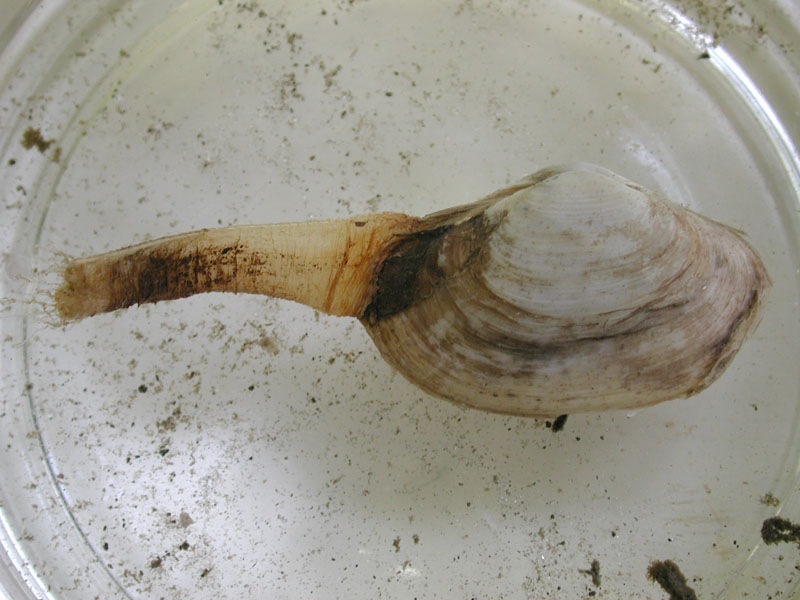
Taxonomy
- Kingdom:Animalia
- Phylum: MOLLUSCA
- SubPhylum:
- Class: Bivalvia
- Order: Veneroida
- Family: Mactridae
- Genus: Mactrotoma
- Species: fragilis
Northern Quahog, $$
Description
The hard clam occurs often in sand or mud, between high- and low-tide lines in shallow coastal waters. This clam is cosmopolitan in distribution, ranging from the Gulf of St. Lawrence in Canada to Florida and Texas, and supports important fisheries and aquaculture industries within its range. The broadly oval, moderately inflated clam has a thick-shelled, solid appearance with equal valves, or shells, and a heart-shaped appearance when viewed with the hinge up. The color is a dull grayish yellow, but can be brownish or black when freshly pulled from the bottom. A subspecies, know as notata, is characterized by reddish or chestnut-colored, chevron-shaped markings on the shell exterior. Many aquacultured clams feature these striated markings. The surface of the shells has many closely-set, erect concentric rings; stronger near the umbo (oldest part of the shell near the hinge) and smoother in the center. Internally the shell is white, sometimes with deep purple at the siphon end. The hard clam can reach up to 5 inches long and over 3 inches in width. The accepted common name is the northern quahog, but it is locally known as hard clam. The name "quahog" (pronounced co-hog) is derived from two Native American words meaning "closed" and "shell." Indians used the purple shell lining to make wampum beads, which were a trading currency in the colonial period. The genus and species names mercenaria (meaning "money" in Latin) refer to their former value. In addition to the regional names for this mollusk, there are different names for hard clams of different sizes. Littlenecks, a reference to the size of the siphons or “necks,” are the most valued aquaculture product size (approximately 1” across the hinge, or width).
What Are The Effects On Clams?
This is the species that clam farmers are growing on their leases and should be found at commercial densities inside the bottom bag.
What Can A Clam Farmer Do?
A clam farmer should first locate his or her growout site (shellfish aquaculture lease) in a suitable area that supports good growth and survival of this species, for example, relatively high salinities and a sand-mud mixture of bottom sediments. Next a clam farmer must not only invest money (“it takes money to make money”), but also his or her management time and skills for the business to be successful (Oesterling, 1995). A clam farmer should also have a basic understanding of the types and abundance of predator and fouling organisms found around the lease area. This information can assist a clam farmer in determining what predator exclusion techniques or planting strategies must be incorporated into the farming methods. Finally, record keeping is an important management tool which allows a clam farmer to evaluate the farm operation and to understand trends and patterns in clam production.
Southern Quahog
Description
Southern quahogs live in sandy bottoms from intertidal flats to 120 feet in depth. The southern quahog resembles the hard clam or northern quahog, M. mercenaria, which is the commercially aquacultured clam. However, the southern quahog seldom has interior purple coloring, and its shells become heavier and more inflated than the northern species. The southern species is best distinguished by persistent growth ridges completely around the shell. An important physiological difference is the shelf life. It is found in the more southern regions of the range of hard clams and the two species are reported to form hybrids. The southern quahog grows larger than the hard clam and can reach 3 to 6 inches in length.
What Are The Effects On Clams?
Southern quahogs are filter feeders and, therefore, can compete for the same type of food (micro algae) as clams.
- FOE
- Competitor
What Can A Clam Farmer Do?
When smaller than normal clams appear in culture bags, they may be southern quahogs or hybrids of southern and northern quahogs. These clams, especially the pure southern quahogs, will have a poor shelf life, as they gape in refrigerated storage, and are not favorable for marketing.
Dwarf Surf Clam, Nut Clam
Description
The dwarf surf clam is the smallest of the surf clams, ranging from Maine to Texas. It is found most often in very calm, fine silty sands or mud, often in estuaries. The valves, or shells, are somewhat triangular, slightly inflated and are rather strong, usually colored white. The umbo, or “beak” of the shell, has a triangular pit in which a ligament is housed that helps keep the valves slightly agape while relaxed. The back slope of each valve has a posterior ridge, and the valves possess a yellow, fibrous periostracum, or shell covering. It grows only to a length of about 5/8 inches.
What Are The Effects On Clams?
Dwarf surf clams are filter feeders and, therefore, can compete for the same type of food (micro algae) as clams.
- FOE
- Competitor
What Can A Clam Farmer Do?
Dwarf surf clams are infrequently found in clam bags and rarely pose a problem.
Ponderous Ark
Description
Ponderous arks are common and live in soft and shelly subtidal habitats in shallow water. The strongly inflated shells have raised square ribs which are slit down the middle with a fine line. The shells have a thick, black, felt-like shell covering (periostracum) which may be worn off near the hinge. Ponderous arks grow up to 2.5 inches in length.
What Are The Effects On Clams?
Ponderous arks are filter feeders and, therefore, can compete for the same type of food (micro algae) as clams. Ponderous arks may recruit into clam culture bags before the bag is buried, since the bags provide optimal habitat. Their “beard” or byssal threads may ball up and trap small clam seed.
- FOE
- Competitor
What Can A Clam Farmer Do?
Ponderous arks are infrequently found in clam bags and rarely pose a problem. It should be noted that ponderous arks are being considered as a potential aquaculture species.
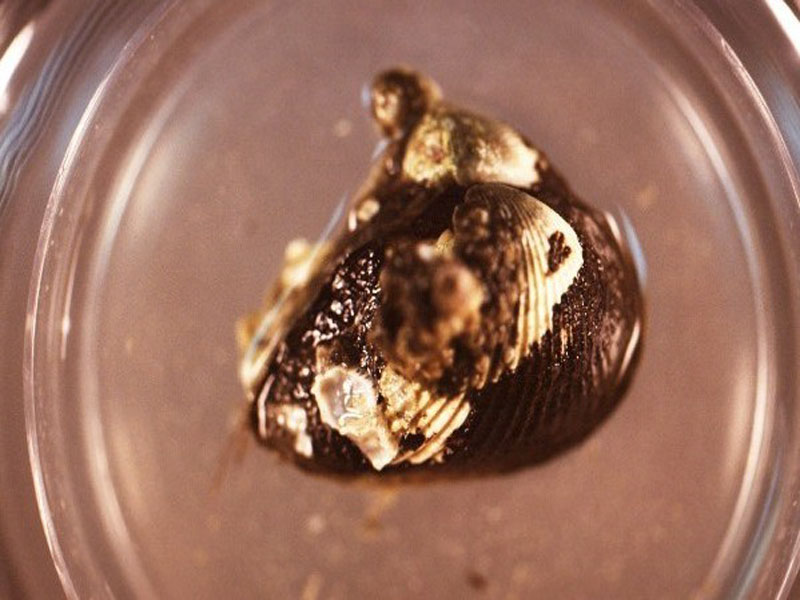
Taxonomy
- Kingdom:Animalia
- Phylum: MOLLUSCA
- SubPhylum:
- Class: Bivalvia
- Order: Arcoida
- Family: Noetiidae
- Genus: Noetia
- Species: ponderosa
Crested Oyster, Horse Oyster
Description
Like eastern oysters, crested or horse oysters cement themselves to subtidal hard substrates. However, they do not form reefs as do the eastern oysters. Crested oysters live in water that is saltier than that in which eastern oysters live. Shells are circular to oval with wavy (crenulated) margins. The shell attached to the substrate is flat inside, but highly cupped. One way to distinguish crested oysters from eastern oysters is by the row of tiny teeth (denticles) on the inside edge of the upper shell, especially near the hinge. These teeth or more easily felt with a fingertip or knife, than seen with the eye. Adults reach 1 to 2 inches in length.
What Are The Effects On Clams?
Oysters can have a two-fold effect on clams. As a filter or suspension feeder, oysters can compete for the same type of food (micro algae) as clams. They can also attach to clam bags and cover netting and to the clam shells themselves. This can result in mechanical interference and prevent the clam from opening, feeding or burying. Fouling on the shell can make them less desirable for marketing. The crested oyster is smaller than the eastern oyster, does not form reefs and prefers higher salinities.
- FOE
- Competitor
- Fouler
What Can A Clam Farmer Do?
To minimize fouling on the clams and bags, a clam farmer could add cover netting during periods of peak sets and remove afterwards, basically harvesting the oysters. Note that plastic or rigid cover netting can also “attract” oyster spat and may become the problem. Dipped bags which stiffen the mesh can also provide suitable substrate for oysters. Clam bags fouled with oysters should be removed from the lease as soon as possible. Gloves are necessary when handling bags covered with oysters as they are very sharp and can cause serious injuries. The crested oyster is less frequently found in and on clam bags than the eastern oyster, and does not pose as great a problem.
Asian Green Mussel
Description
This green mussel is native to the Indo-Pacific and is assumed to have arrived in the U.S. as larvae in ship’s ballast tanks. They were discovered in Tampa Bay in 1999 and have since become established. Like other mussels, green mussels attach to firm substrates by a “beard,” or byssal threads. They seem to prefer attaching to man-made structures. Their dense growth has been correlated with oyster mortality on oyster bars, and they appear to outcompete native bivalves for space on structures. They can tolerate salinity and turbidity extremes well and are efficient filter feeders. Green mussels have bright green to blue-green shells that develop brown markings in adulthood.
What Are The Effects On Clams?
Green mussels are an invasive species and are established in Tampa Bay. They recruit in dense numbers on hard substrate and prefer artificial structures. They will also attach to other shellfish and have been correlated with high oyster mortalities. If green mussels spread north from Tampa Bay to the Suwannee Sound, clam growers could expect extensive fouling of clam culture bags by green mussels, potentially suffocating the clams, as well as competing with them for food.
- FOE
- Competitor
- Fouler
What Can A Clam Farmer Do?
If a suspected green mussel is sighted, growers should report to the Nonindigenous Aquatic Species Program at 877-STOP-ANS or on the Internet at http://nas.er.usgs.gov. If possible, save samples of the shells.
Purplish Semele
Description
Purplish semele clams live in shallow subtidal waters. The thin shells are lopsided oval in shape and are thin and smooth except for very fine growth rings overlaid by very fine grooves. The color is variable but they are usually gray or cream with purple or orange mottling. The inside of the shell is glossy purple, orange, or brown. Purplish semele clams reach 1 inch in length.
What Are The Effects On Clams?
Purplish semele clams are found infrequently in culture bags. They are deposit-feeders, consuming sediment and extracting the organic material. They would, therefore, remove and recycle clam fecal material from culture bags.
- FRIEND
What Can A Clam Farmer Do?
As non-competing deposit feeders, purplish semele clams can remain in the culture bags.
Atlantic Surf Clam
Description
Atlantic surf clams live in unstable shifting sand in tidal channels or beaches in the high subtidal to low intertidal. The shells are smooth and triangular with the hinge centrally located. The shell is white with a thin, glossy, yellowish shell covering (periostracum). Atlantic surf clams may exceed 8 inches in length but are usually less than 4 inches.
What Are The Effects On Clams?
Atlantic surf clams are filter feeders and, therefore, can compete for the same type of food (micro algae) as clams.
- FOE
- Competitor
What Can A Clam Farmer Do?
Atlantic surf clams are infrequently found in clam bags and rarely pose a problem.
Purplish Tagelus
Description
Purplish tagelus clams are common intertidal to shallow water species. They inhabit permanent burrows in mud or muddy sand that are often “J”-shaped. The elongate shells are smooth and fragile. Shell color is whitish purple and the shells are covered by a thin, glossy chestnut brown covering (periostracum). Purplish tagelus clams reach 1.5 inches in length.
What Are The Effects On Clams?
Purplish tagelus clams are filter feeders and, therefore, can compete for the same type of food (micro algae) as clams. On the other ‘shell’, their burrows may help aerate the sediments.
- FRIEND, FOE
- Competitor
What Can A Clam Farmer Do?
Purplish tagelus clams occur infrequently in clam bags and rarely pose a problem.
Florida or Yellow Prickly Cockle
Description
Florida or yellow prickly cockles live in sand in shallow to intertidal waters. When viewed end on, they have a slender heart-shaped profile. When viewed from the side, the shells are nearly circular, with rough scaly ribs. The outside shell color is often yellowish with brown mottling, while the inside of the shells are yellow. Yellow prickly cockles grow to 2.5 inches in size.
What Are The Effects On Clams?
Florida or yellow prickly cockles are filter feeders and, therefore, can compete for the same type of food (micro algae) as clams.
- FOE
- Competitor
What Can A Clam Farmer Do?
Yellow prickly cockles are infrequently found in clam bags and rarely pose a problem.
